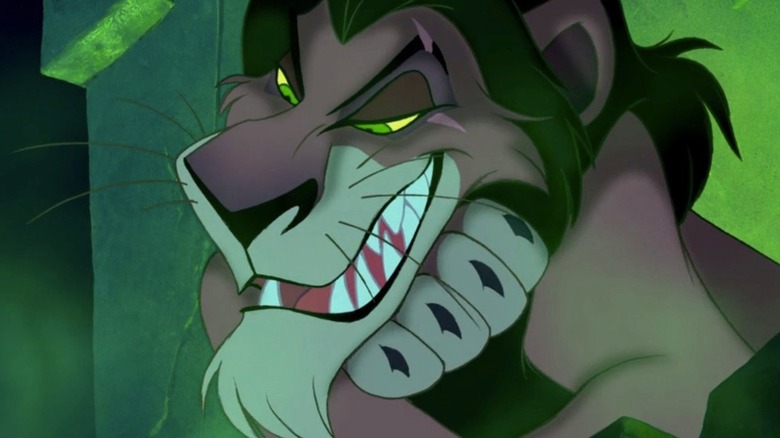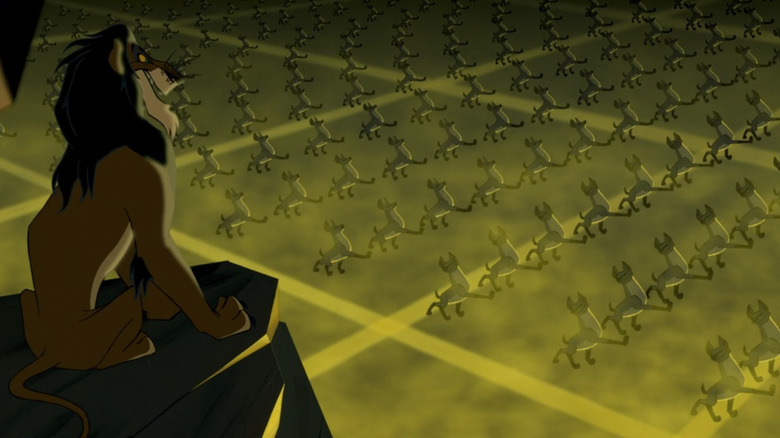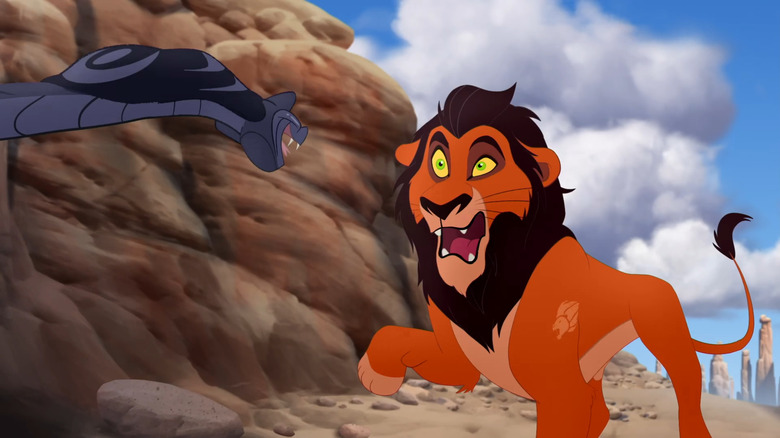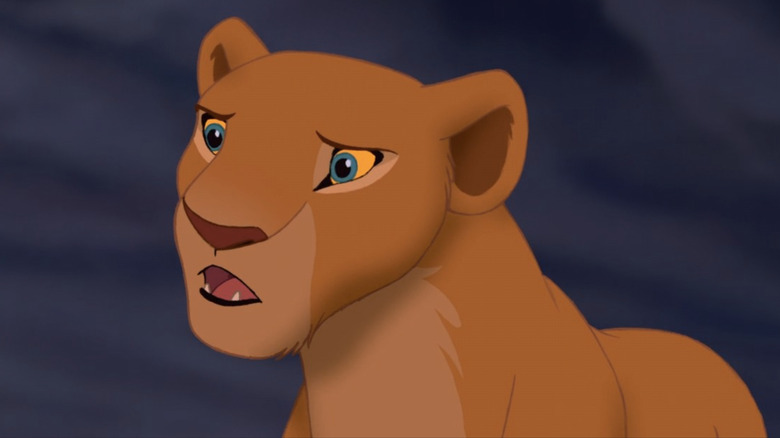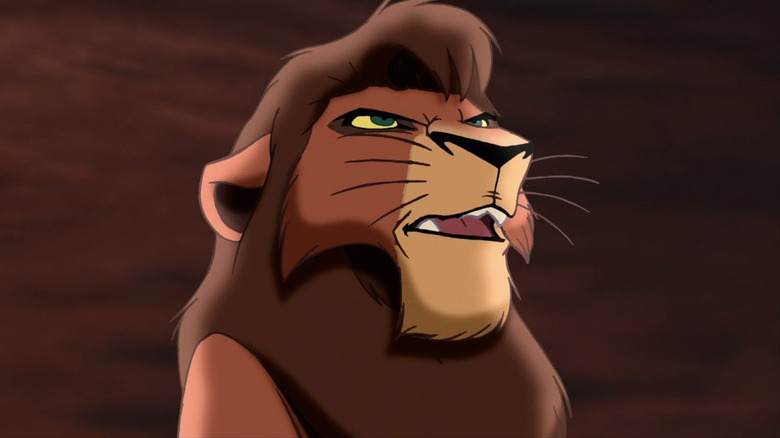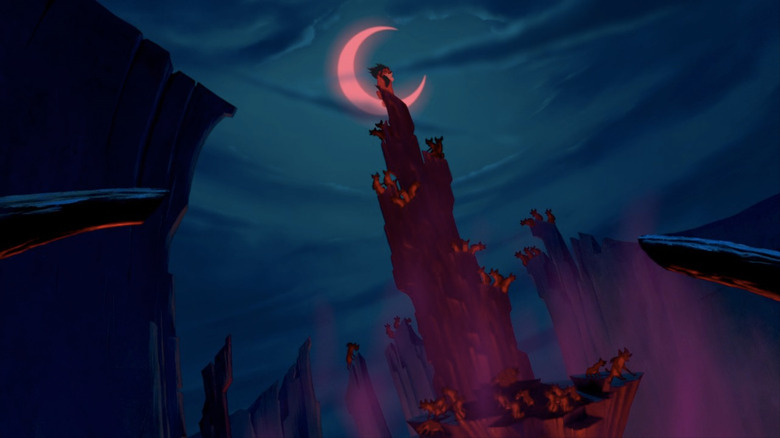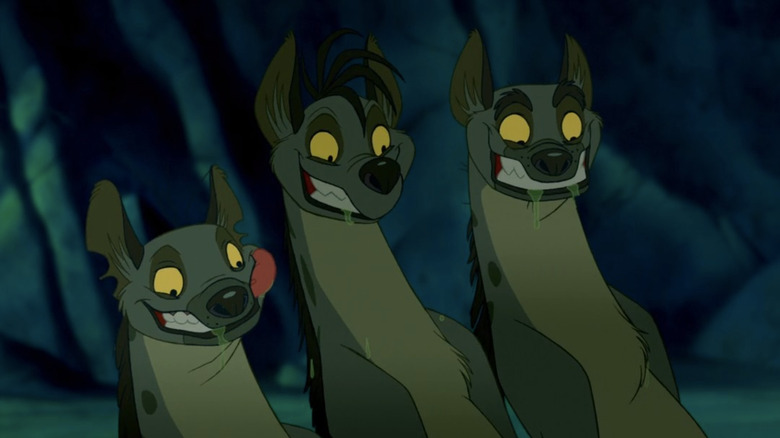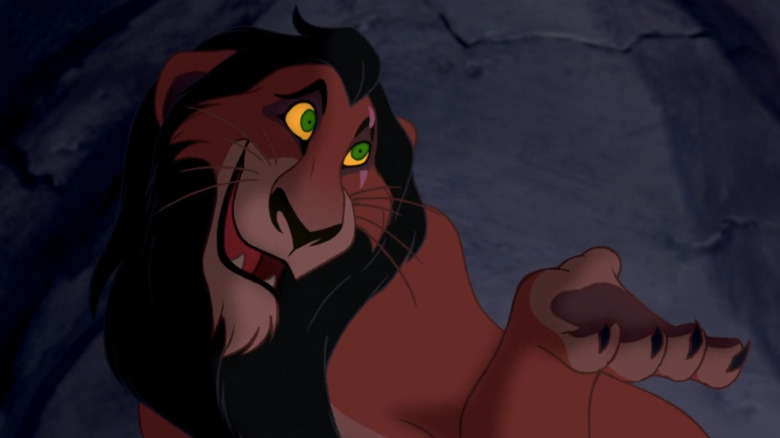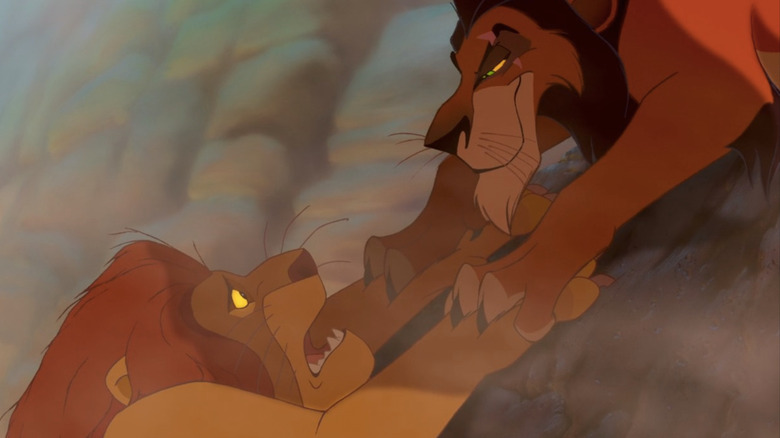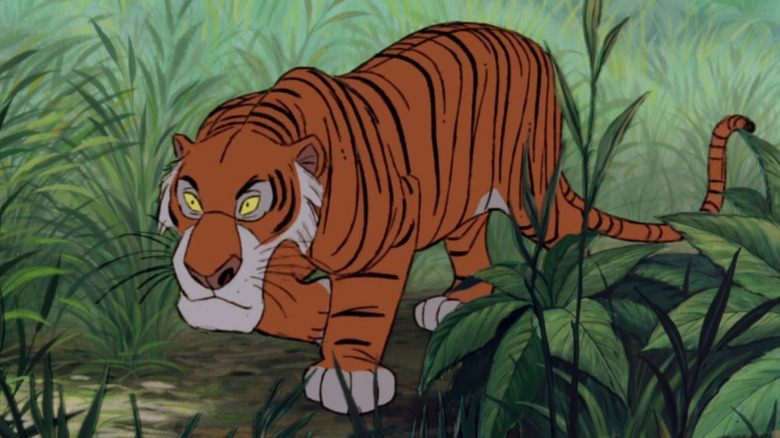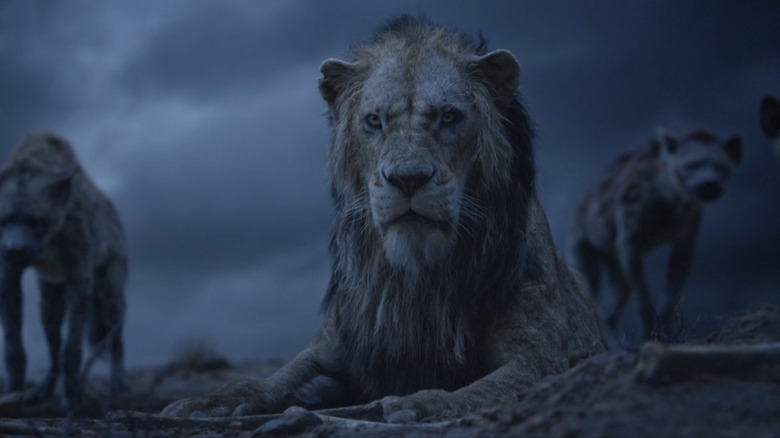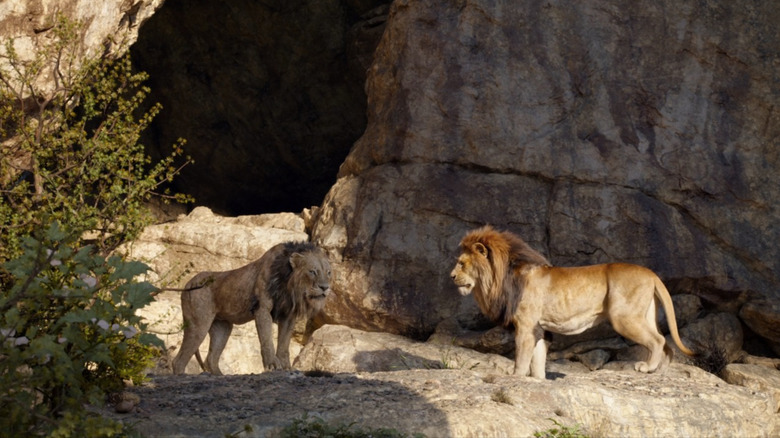The Dark History Of Scar From The Lion King
When considering Hollywood's most menacing movie villains, the conversation is incomplete without mentioning Scar, the rogue relative in "The Lion King" with a flair for the dramatic and an appetite for power. Scar's notoriety certainly earned its place in movie history — the 1994 classic from Walt Disney Animation Studios remains the highest-grossing hand-drawn film ever, while its 2019 remake is the highest-grossing computer-animated movie of all time.
Scar even stands out among Disney's pantheon of nefarious villains. The deeds they commit and the destruction they cause just can't compare to his reign of terror. Scar isn't just bad — he's pure evil. He doesn't just swipe the throne — he kills his own brother to do so, the aftermath of which isn't glossed over but instead viscerally confronted. The emotional damage Scar inflicts upon the Pride Lands and the physically weakened state he leads the kingdom into is raw, sorrowful, and calamitous ... that is, when a flatulent warthog isn't onscreen to balance things out.
Scar is anything but one-dimensional, and in the nearly three decades since he first made his debut, Disney has gone to great lengths to maintain the would-be king's reputation as one of the studio's most terrifying bad guys. What's Scar's backstory? What makes him tick? How has his legacy been adapted or changed as time has gone on? This is the dark history of Scar from "The Lion King."
A disturbing moment in history inspired Be Prepared
A handful of Disney villains have a signature song in which they plot their scheme to take down the hero. What would Ursula be without "Poor Unfortunate Souls?" How can anyone imagine Doctor Facilier without thinking of "Friends on the Other Side?" Scar's big moment is "Be Prepared," in which he rallies his hyena henchmen to plan Mufasa's murder.
As Disney animators developed the story, Scar's rise to power — leading a large group of soldiers to eradicate life and seize control of his homeland — reminded them of something. They turned to World War II propaganda footage in determining the aesthetic for Scar's rule, according to "The Lion King: The Full Film Script" book by Bill Scollon and Barbara Montini. Winding back the clock of history further, co-director Rob Minkoff shared with Scollon and Montini that the crew was inspired by 1930s footage to stylize segments of "Be Prepared" with yellow and black to mimic vintage newsreels of the Depression era.
The finished product — whether the audience consciously is aware of the source inspiration or not — is a chilling moment as Scar unfolds his plan, which he ultimately, and unfortunately, succeeds in executing.
The origin of Scar's nickname
Scar does, indeed, have a scar across his left eye. However, throughout the entirety of "The Lion King," the script never addresses if it's a birthmark or the result of some sort of accident, nor does it specify if "Scar" is actually the lion's real name or a nickname. The answers wouldn't come until two decades after the original film's release.
In the late 2010s, Disney Television Animation produced a series called "The Lion Guard," in which Simba's son, Kion, protects the Pride Lands as leader of the titular task force team. Though long since deceased, Scar makes occasional guest appearances in "The Lion Guard" from the afterlife in ghost form. It's through this that we actually see the tragic origin of Scar's turn from good to evil.
It turns out that Scar used to lead the Guard himself until one day it all went wrong. While under the mentorship of a mischievous lion, Scar was struck in the face by a venomous snake. He was left with a gnarly gash across his eye, and Mufasa mockingly gave his brother a nickname that stuck. In the aftermath of this shaming, Scar grew more and more vengeful until he was stripped of his Lion Guard duties and vowed to one day dethrone Mufasa.
Scar wanted Nala as his lion queen
Prior to Scar's 1994 debut, there was an unsettling precedent for Disney male villains to be predatorial over heroines who wanted nothing to do with them. In 1991's "Beauty and the Beast," Gaston spends the length of the film trying to force Belle to marry him, and in 1992's "Aladdin," Jafar wishes for Genie to make Jasmine fall in love with him against her will.
In a deleted scene from "The Lion King," Scar would've followed suit by demanding a sexual partnership with someone quite unexpected: Nala. The scene would've come just before Nala leaves the Pride Lands to search for help during Scar's reign. At this point in the story, Scar theorizes that even though he's achieved his goal to be king of Pride Rock, now he wants to be a father, and he wants Nala to be his cubs' mother.
The sequence was cut from the movie but later included in the Broadway musical, where it lives on as the song "The Madness of King Scar," written by Elton John and Tim Rice. During the song, Scar thinks aloud, "Without a queen, what am I? A dead end, no line, no descendants, no future. With a queen, I'll have cubs! Immortality will be mine!" As Nala enters the scene, Scar creepily continues, "Ah, Nala ... your timing couldn't have been more perfect. My, how you've grown." Nala, of course, refuses his demand and leaves to save Pride Rock.
Scar's long-term plan for Pride Rock
In the 1998 sequel "The Lion King 2: Simba's Pride," Simba's daughter, Kiara, falls for a cub named Kovu. The pair quickly discovers their romance is forbidden by a complicated, prejudiced history between Simba and Zira, Kovu's mother. While the details are never fully explained and there are some pretty significant gaps of off-screen plot development, the audience is able to gather that Scar had more of a plan than it seemed in the first "Lion King."
Zira, Kovu, and other outlaw lions never appeared in the 1994 classic. In fact, Scar seemed to be the one and only villainous lion, with all of his accomplices being hyenas. However, Kovu's family was apparently present within the story all along. In "The Lion King 2," Zira explains to Simba that Kovu was "hand-chosen by Scar to follow in his paw prints and become king." She continues, "Kovu was the last born before you exiled us to the outlands." There's a lot to unpack here, and it may or may not actually make sense with what was already established in the preceding film, but all the same, it shows Scar had plenty of secrets. What else don't we know about him?
Jeremy Irons didn't sing all of Be Prepared
Actor Jeremy Irons voices Scar in "The Lion King" and sings most of Scar's song, "Be Prepared." While Disney hopes you've never noticed — as that's entirely the point — the last verse of the villain's signature song is instead performed by prolific voice actor Jim Cummings.
Speaking with the HuffPost, Cummings shared, "Jeremy developed vocal problems while he was recording that number for 'The Lion King,' so the producers asked me to come in and replace Mr. Irons. Sing the last third of 'Be Prepared' in his place." If you listen closely, you may be able to tell the slightest of differences in Scar's voice toward the end of the song, but the magic trick is pulled off expertly, and it's hardly noticeable.
Incidentally, Cummings also voiced Ed, the crazy, shrieking hyena. Cummings has dozens of credits voicing Disney characters across the decades, including Winnie the Pooh, Tigger, Darkwing Duck, and Pete (frequent rival of Mickey Mouse and/or Goofy, depending on the project).
A villain veteran animated Scar
When it came time to animate Scar, the man in charge of overseeing the lion certainly knew a thing or two about bringing bad guys to life. Scar's supervising animator was Andreas Deja, a longtime Disney artist who was no stranger to iconic villains, having previously animated Gaston in "Beauty and the Beast" and Jafar in "Aladdin." Some of Deja's other characters included the titular star of "Who Framed Roger Rabbit" and King Triton in "The Little Mermaid." Later, his achievements would include the likes of adult Herc in "Hercules" and Lilo in "Lilo & Stitch."
In a bonus feature on the 2003 DVD release of "The Lion King," Deja shared his passion for animation. "To me as an animator, I really feel like an actor, even though we work with a pencil," Deja says. "We don't put ourselves in front of the screen, but it really is acting. People ask me sometimes, 'Oh, you have to do all these drawings. Aren't you getting bored?' We don't think about drawing, we think about acting."
Scar's relationship with the hyenas solved a story problem
As development of "The Lion King" got underway, issues involving the tone of the film necessitated that a new co-director, Rob Minkoff, join existing co-director Roger Allers and that major story revisions take place. During this process of reconsidering all aspects of the film and adjusting as needed, filmmakers discovered hyenas could be the perfect foil to Scar as his henchmen, as chronicled in "The Lion King: The Full Film Script" book by Bill Scollon and Barbara Montini.
This revelation came from a viewing of the National Geographic documentary "Eternal Enemies: Lions and Hyenas." The crew became fascinated by the real-life relationship between these two animals and felt that this nature-driven precedent fit perfectly within the story they were trying to tell, even going as far as inviting the documentary's producers to visit the studio to explain it in greater detail. Minkoff described to Scollon and Martini that, "The documentary is so powerful because it really deals with the life-and-death struggle of being ... a lion or hyena. I remember saying that if our movie is half that powerful, it would [really] be something."
One visual detail sets Scar apart from other lions
With a film as beloved as "The Lion King," odds are that you've at least seen it a few times over the decades. As such, each viewing yields new discoveries you might not have noticed the first time around — in particular, small details and symbolic motifs that can perhaps only ever be truly appreciated having known the context for the whole story.
In addition to the visual cues in Scar's design that make him look sinister, sharp-eyed audience members may notice that Scar is the only lion in the film whose claws are visible, as pointed out by author Jeff Kurtti in the book "Disney Dossiers: Files of Character from the Walt Disney Studios." Mufasa, Simba, Nala — all of these lion characters have claws just like Scar, but the animators chose to conceal them. By making Scar the only character among the cast whose claws are visible, the filmmakers have subtly suggested that Scar will do whatever it takes to strike down anyone who stands in between him and the throne of Pride Rock.
An interesting adaptation of this detail is continued in "The Lion King 2: Simba's Pride." Kovu, the lion meant to follow in Scar's stead, begins the movie with his claws visible. However, as Kiara, Simba's daughter, falls in love with Kovu and his spirit softens, his claws disappear.
Test audiences wanted to undo Scar's biggest sin
While a film is still in production, it's common for a studio to host test screenings, at which an audience watches an unfinished cut of the movie and provides honest feedback. Sometimes this outside perspective is just what a crew needs to bring to light elements of the story that just aren't working and fix them by the time the movie is released. Other times, there's simply nothing filmmakers can do to rectify feedback from a screening, as was the case for a test audience's reaction to Scar.
Scar's most vile act as the movie's villain is murdering his brother, Mufasa. The entire murder sequence, while cinematically well-done, is emotionally traumatizing. The audience sees Scar fling Mufasa into the wildebeest stampede. They see Simba scream for his father's death. They see him cry beside his father's dead body and wrap himself in his dad's limp paw. It's a heavy scene.
As shared in "The Lion King: The Full Film Script" book, audiences in test screenings pleaded for filmmakers to reconsider Mufasa's death, saying it was too sad. That was a major no-go. This moment sets into motion Simba's journey and ultimately lays the foundation for the film's big message about overcoming life's greatest hardships. Scar has to win, at least temporarily. Obviously, the crew kept Mufasa's death in the finished movie despite the feedback.
Scar's animator rejected a tempting source of inspiration
"The Lion King" marked a departure from most other Disney animated films of its era in that its cast was comprised entirely of animals. Not a single human is in the movie, and the lions' physique, while certainly exaggerated in some ways, is meant to emulate that of their real-life feline counterparts. As a result, the chief animator behind Scar decided to ignore what could've been a very obvious source of inspiration.
Andreas Deja, supervising animator of Scar, grew up loving the 1967 Disney classic "The Jungle Book." Despite this, Deja resisted studying the film during his time with Scar. "I didn't look at 'Jungle Book' at all while working on 'Lion King,'" Deja shared in a 2011 documentary. While there are no lions in that film, there are plenty of four-legged wild animals whose motions would've made sense to mimic — notably the villainous tiger Shere Khan. "The temptation would've been to take too much of what they did and just use that," Deja elaborated. "I just went back to real lions as much as I could and Jeremy Irons' face and mix that up."
Character designers faced a challenge for the remake
For the 2019 remake of "The Lion King," director Jon Favreau had a strict mandate that all characters could only have physical traits that their real-life counterparts have in the wild, as shared in the book "The Art and Making of The Lion King" by Michael Goldman. Therefore, rather than the villainous, cartoony flair Scar has in the original 1994 movie that immediately signals he's the bad guy, filmmakers of the remake had to take a different approach in designing Scar. If he could only look like an actual lion, what were the natural physical features a real cat might have to indicate an antagonistic personality?
Production designer James Chinlund explained to Goldman that the crew pitched Scar as the runt of his litter. "Not necessarily runt-size," Chinlund explained, "but runt as in not getting a fair shake. Therefore, he has a receding hairline, a slightly bleached-out color, his eyes are much lighter — things that might suggest that perhaps he didn't receive as many nutrients as a young cub as his more powerful brother."
Light plays a crucial role in Scar's presence
Clever filmmakers can infuse color theory into their art by using color to evoke an emotion or embody a character. In the case of Scar in the 2019 remake of "The Lion King," the film's crew almost always used darkness as they showcased their villain, as shared in "The Art and Making of the Lion King" by Michael Goldman. "We tended to put him in shade, or for night scenes with the hyenas, we added elements that suggest he is a dark character," cinematography Caleb Deschanel shared with Goldman.
This technique worked especially well when Scar shared scenes with characters embodying heroic personas, like his brother Mufasa. "With Mufasa occupying the sunny side of the rock and Scar the dark side, [it] was meant to reinforce the more sinister aspects of his character," said production designer James Chinlund, highlighting the concept of light vs. darkness that makes up such a big part of "The Lion King's" story.
